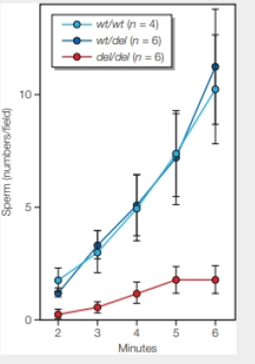
Stuck Sperm Cells lining the epididymis secrete a glycoprotein (beta-defensin) that coats sperm and facilitates their passage through cervical mucus. There are two common alleles for human beta-defensin: a wild-type allele (wt) and an allele with a deletion (del). To find out if this

FIGURE 41.12 Effect of beta defensin genotype on the ability of sperm to penetrate a gel that simulates cervical mucus. Sperm from 16 men was tested: 4wt/wt, 6wt/del, and 6 del/del.
Fresh sperm were placed on one side of the gel, and a video camera was focused on a region 2.75 mm into the gel. The number of sperm in this region was recorded at one-minute intervals for six minutes. Sperm numbers shown are averages. Bars indicate range.
After four minutes, how many sperm from men with a wild-type allele were in the camera's view an average?
To determine: The number of sperms from men with a wild-type allele were in the camera’s view on average.
Introduction: The epididymis is a part of the male reproductive system. Through the epididymis, the sperms travel from the testis to the vas deferens.
Explanation of Solution
An experiment was performed by researcher GC and colleagues about the effect of beta-defensin genotype on the ability of sperm to penetrate a gel that can stimulate cervical mucus. The cells of the epididymis secrete a beta-defensin protein that aids the sperms to pass through the cervical mucus of the female. The research team conducted an experiment to check whether the beta-defensin has any role in fertility. One allele of the gene coding for the beta-defensin was wild-type and the other allele was a mutated one. A barrier similar to cervical mucus was created in the form of a gel. The sperms were placed at one end of the gel and a video was recorded to check how many sperms with wild-type and mutated gene passed into the gel in the course of time.
A graph was plotted for time (minutes) on the X-axis and the number of sperms on the Y-axis for both the alleles of the beta-defensin gene.
Based on the values in the graph in Fig. 41.12, post four minutes, the men who have sperms with wild-type allele for beta defensin protein had six sperms within the camera view on average.
On average, six sperms were within the camera view after 4 minutes.
Want to see more full solutions like this?
Chapter 41 Solutions
Biology: The Unity and Diversity of Life (MindTap Course List)
Additional Science Textbook Solutions
Chemistry: Structure and Properties (2nd Edition)
Genetics: From Genes to Genomes
Campbell Essential Biology (7th Edition)
Microbiology Fundamentals: A Clinical Approach
Human Physiology: An Integrated Approach (8th Edition)
- What is behavioral adaptarrow_forward22. Which of the following mutant proteins is expected to have a dominant negative effect when over- expressed in normal cells? a. mutant PI3-kinase that lacks the SH2 domain but retains the kinase function b. mutant Grb2 protein that cannot bind to RTK c. mutant RTK that lacks the extracellular domain d. mutant PDK that has the PH domain but lost the kinase function e. all of the abovearrow_forwardWhat is the label ?arrow_forward
- Can you described the image? Can you explain the question as well their answer and how to get to an answer to an problem like this?arrow_forwardglg 112 mid unit assignment Identifying melting processesarrow_forwardGive only the mode of inheritance consistent with all three pedigrees and only two reasons that support this, nothing more, (it shouldn't take too long)arrow_forward
- Oarrow_forwardDescribe the principle of homeostasis.arrow_forwardExplain how the hormones of the glands listed below travel around the body to target organs and tissues : Pituitary gland Hypothalamus Thyroid Parathyroid Adrenal Pineal Pancreas(islets of langerhans) Gonads (testes and ovaries) Placentaarrow_forward
 Human Biology (MindTap Course List)BiologyISBN:9781305112100Author:Cecie Starr, Beverly McMillanPublisher:Cengage Learning
Human Biology (MindTap Course List)BiologyISBN:9781305112100Author:Cecie Starr, Beverly McMillanPublisher:Cengage Learning
 Human Heredity: Principles and Issues (MindTap Co...BiologyISBN:9781305251052Author:Michael CummingsPublisher:Cengage Learning
Human Heredity: Principles and Issues (MindTap Co...BiologyISBN:9781305251052Author:Michael CummingsPublisher:Cengage Learning Biology (MindTap Course List)BiologyISBN:9781337392938Author:Eldra Solomon, Charles Martin, Diana W. Martin, Linda R. BergPublisher:Cengage Learning
Biology (MindTap Course List)BiologyISBN:9781337392938Author:Eldra Solomon, Charles Martin, Diana W. Martin, Linda R. BergPublisher:Cengage Learning Biology: The Unity and Diversity of Life (MindTap...BiologyISBN:9781305073951Author:Cecie Starr, Ralph Taggart, Christine Evers, Lisa StarrPublisher:Cengage Learning
Biology: The Unity and Diversity of Life (MindTap...BiologyISBN:9781305073951Author:Cecie Starr, Ralph Taggart, Christine Evers, Lisa StarrPublisher:Cengage Learning Concepts of BiologyBiologyISBN:9781938168116Author:Samantha Fowler, Rebecca Roush, James WisePublisher:OpenStax College
Concepts of BiologyBiologyISBN:9781938168116Author:Samantha Fowler, Rebecca Roush, James WisePublisher:OpenStax College





